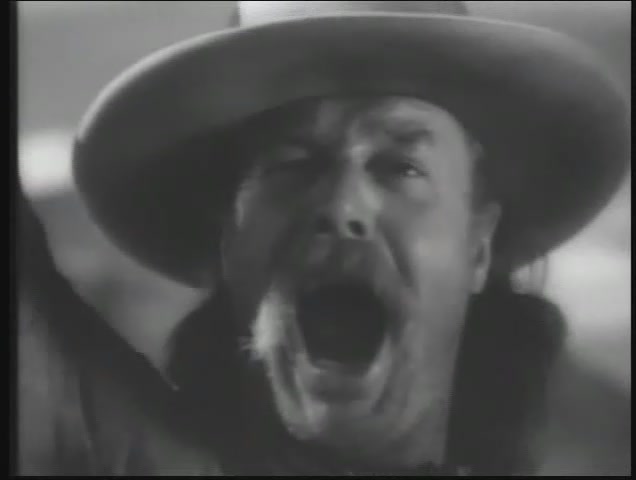THE American WESTERN
By Jeffrey-Baptiste Tarlofsky
By Jeffrey-Baptiste Tarlofsky
Lesson 10 consists of six video lectures and transcripts of those lectures, and five film excerpts. Start with excerpt #1 from Red River and continue down the page in sequence until you reach the end of the lesson.
レッスン10は6本のビデオレクチャー(レクチャーのテキストがビデオレクチャーの下に記載されています)と5 本の動画で構成されています。
このレッスンは、ページをスクロールダウンしながら最初から順番に動画を見たりテキストを読んでください。
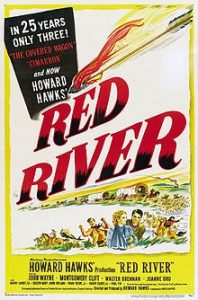
Directed & produced by: Howard Hawks
Screen play by: Borden Chase
Starring: John Wayne, Montgomery Clift, Walter Brennan, Joanne Dru
Music by: Dimitri Tiomkin
Distributed by: United Artists
Running time: 133 minutes (Pre-release) 127 minutes (Theatrical)
Budget: $2.7 million
Box office: $9,012,000
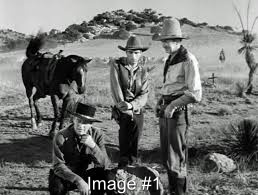
Fifteen years later we still see this family with three distinct generations.
Part 1 – The first thing we learn in this scene is that a lot of time has passed since Dunson spoke about making his ranch. Almost fifteen years have passed. Here we are again looking at the same three people, but they have aged. The young boy Matt, who was only fourteen years old when we met him, has become a full-grown man (now played by Montgomery Clift in his first starring role). Groot and Dunson have also obviously aged as well, which we can see from their grey hair. From studying both the film and the story the film is based on, I feel fairly confident that I can tell you how old each character is supposed to be at this point in the film. Groot (being played by the 54-year-old actor Walter Brennan) would be sixty-eight years old, Dunson (played by the 41-year-old actor John Wayne) would be fifty-four and Matt (played by the 28-year-old Montgomery Clift) would be his own age of twenty-eight. So the actors Walter Brennan and John Wayne are both playing characters about fifteen years older than their actual ages. This, by the way, is exactly the opposite of what Wayne had done in Stagecoach when he played the part of the eighteen-year-old Ringo Kid when he was actually thirty one years old. I think it is much to John Wayne’s credit that he handles both parts beautifully in these films. Remember that John Ford actually said “I didn’t know the big son of a bitch could act”. Well, he’ll have to act if he is going to keep up with his co-star, Montgomery Clift. Clift as Matt is playing a man of his own age, but he will have plenty of other challenges in the role of Matthew Garth.
Why talk about age? I do think the age differences between the characters are significant. The age differences between the three of them almost gives us three generations of a “family”. Although Groot is only fourteen years older than Dunson and therefore not quite old enough to be his father, Dunson is quite old enough to be Matt’s father. But there are other very interesting interpretations of the age differences which I will discuss later. For now, just keep their ages in mind.
Another thing to keep in mind, or in sight, is that bracelet. It has moved again. First Tom gave it to his girlfriend in what was all but a proposal of marriage, next we saw it on the wrist of the Comanche warrior who probably murdered Tom’s fiancée to get it, and then it went back to Tom after he kills the warrior.
Pause…
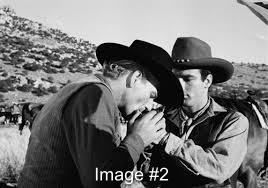
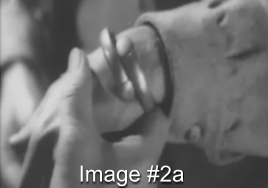
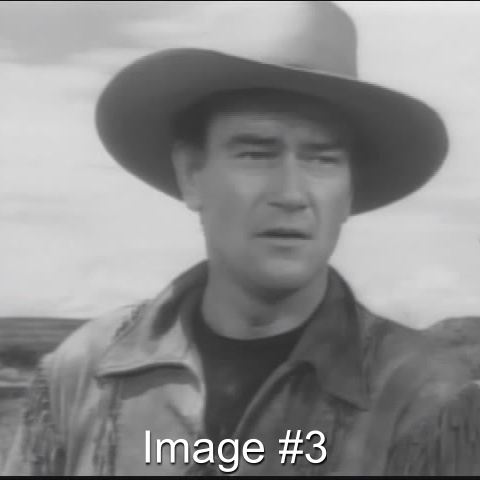
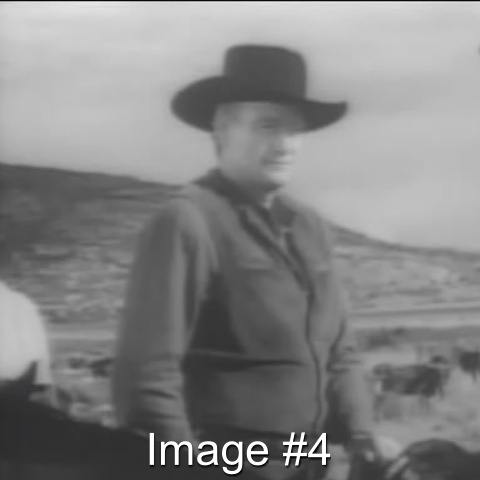
For your homework reading for this lesson you will be reading about the economic situation Tom, Matt and Groot discuss in this important scene and I think you will understand better why Tom and Groot really were scared and were relieved to have Matt come home. Groot admits he can’t ride a horse well anymore and Tom is no longer a young man, either, as we see from the fact that Matt helps him get up. Both men are glad to have Matt home again because they have missed him, but they are also counting on Matt to help them with the cattle drive. Matt has the youthful energy they don’t. Tom and Groot must both be pretty glad they rescued that half-crazy boy and his cow all those years ago because now they are counting on that boy to rescue them now. As Groot explains it, Tom just doesn’t understand what he is fighting. To a man like Tom it seems obvious that if you work hard for fifteen years and have 10,000 head of cattle you should not be facing bankruptcy. As Groot and Matt talk we see that behind them there are seven simple graves…the graves of men Tom has killed over those fourteen years, the graves of seven men who, as Groot says, “tried to take the land from him”. Is the Mexican guard counted in that number? He was the first man Tom killed for this land. Is his the first grave? Were any of the others men sent by Don Diego to enforce his claim to the land or were they perhaps other men like Tom who thought the same way Tom did, that all they needed to do to take the land was kill for it? But Tom has always been faster than they were, always “watched their eyes” as he told Matt to do in his first lesson about gun fighting. As Groot says “he understands that kind of fight”.
But has killing all these men changed Tom? Look at images #3 and #4. Before you go to Part 2, write down in your notes the difference that you see between the two images.
Part 2 – In 1851 Tom is wearing a white hat while in 1866 he is wearing a black hat. Does that mean something in this film? It certainly meant something in both Cimarron and Stagecoach in which the good guys wore the white hats and the bad guys wore the black hats. But does it mean something in Red River where the same character changes from wearing a white hat to wearing a black hat? What do you think Howard Hawkes was doing?
Finally, let me draw your attention to the point in excerpt #1 just before Tom rides away. Matt is lighting Tom’s cigarette and Tom sees the bracelet, but Tom has also noticed that Matt has a new gun and he remarks that it is a “mighty nice looking gun”. Groot understands what Tom wants him to do. As Matt turns to get Tom’s horse, Groot playfully shouts “draw!” and Tom and Matt both draw their guns as fast as they can. It seems to be an old game they have played many times before, but Groot has a good laugh because it seems to him that at long last Matt has become faster than Tom. Maybe he has…maybe. By the way, this is called “foreshadowing” and you should look up the meaning of that word because this film uses foreshadowing repeatedly (and of course I will ask it about it in the next quiz….hint, hint!)
Part 3 – We have already discussed why branding was important in the old west, but obviously it was not a perfect method for keeping track of cattle. The obvious reason for branding your cattle was so you and other ranchers would know which cattle belonged to you. But the other reason for branding was to be able to identify your cattle if they were stolen. The theft of cattle or “cattle rustling” as it was called, was and still is a serious crime in the American west. In Texas today a cattle rustler can receive up to ten years in prison for the theft of only one cow. At the time Red River is set, 1866, the penalty for cattle rustling was hanging, in other words, death. One way that cattle rustlers avoided being caught was by either altering brands to look like another brand or simply burning a new brand over and old one. This is what Dunson orders his men to do with all the cattle they have rounded up regardless of who owns them. This is theft. Tom is rustling his neighbor’s cattle.
Mr. Meeker, Dunson’s neighbor, suspects that Dunson might be doing just this and he rides over with his men to Dunson’s ranch to investigate. Mr. Meeker is polite, but make no mistake about this, he suspects Dunson is rustling his cattle to take them on the cattle drive. Dunson and Meeker obviously know each other well and it is likely their cowboys all know each other and are probably all friends. But, this is still a tense situation as we see by the fact that when one of Meeker’s men moves slightly to the side of Dunson, Tom says sharply, “Can’t you hold that horse still?”. He is warning the man not to try to get behind him…and when Dunson gives you a warning, it is wise to take it seriously. The tension increases greatly when Matt and Cherry Valance start to talk to each other. Cherry Valance is obviously no ordinary cowboy. Again, we have that signature of Howard Hawkes’ where the dialogue overlaps and people interrupt one another. Hawkes using the dialogue to build tension in the scene and that tension shifts from being between Dunson and Meeker to being between Matt and Cherry. It is as if Dunson and Meeker have a couple of attack dogs straining at their leashes eager to fight…if they let go of the leashes.
Matt and Cherry are not ordinary cowboys and everyone around them knows this. These young men are both “gunslingers”. A gunslinger was not necessarily a criminal. He might be an outlaw, or he might be a lawman or he might just be a cowboy or anything really. The word “gunslinger” simply means “a master of the quick draw and an accurate shot”. All the way back in the film Cimarron we saw that the good guy, Yancey Cravat, was a gunslinger. We saw how fast he could draw and accurately he could shoot when he shot off the bottom of the bad guy’s ear.
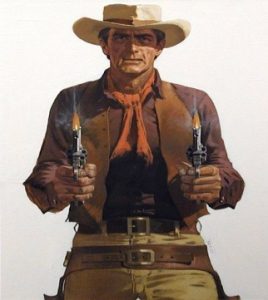
In the old West every cowboy and most other men carried guns, but a true gunslinger was very rare. Think about the difference between an ordinary samurai and a master swordsman like Musashi Miyamoto. All samurai knew how to use their swords expertly, but obviously they did not approach the level of skill of a true master swordsman like Musashi Miyamoto. The same was true of western men. They all knew how to use guns, but everyone knew a normal cowboy would have no chance in a gunfight against a true gunslinger. Everyone near his ranch would know that Thomas Dunson was an extremely dangerous gunslinger as he has proven seven times before. Dunson has taught Matt how to shoot and we know that Matt is now as fast (or faster) than Dunson. This is why Matt isn’t at all afraid of Cherry Valance and that makes Cherry Valance very curious.
Cherry is actually thrilled to meet someone like Matt precisely because Matt isn’t afraid of him. Cherry is both curious and eager for action so he quits Mr. Meeker and insists on joining Dunson’s cattle drive. Amused by Cherry, Dunson agrees to hire him. It never hurts to have another gunslinger along on a dangerous trip and maybe he thinks Cherry will be a good test for Matt at some point. In the next excerpt the young men get a feel for each other.
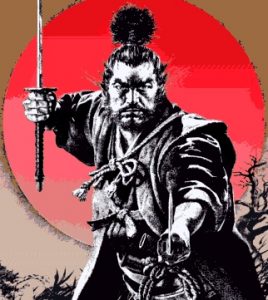
Cherry and Matt have a shooting contest in which each one realizes just how good the other is. They have earned each other’s respect. Cherry remarks, “That puts two of us at the head of the list” but Matt tells Cherry he’d better add Dunson because he is Matt’s teacher. Both young men certainly talk tough and seem really cool, but the only thing we have seen either of them shoot is tin cans. On the other hand, we have seen the seven graves of the men Dunson has killed.
The shooting contest between Matt and Cherry is another instance of foreshadowing. In case we missed the point, Groot tells us, “those two are going to tangle for sure and it won’t be pretty when they do”. Will these two end up like Musashi and Kojiro?
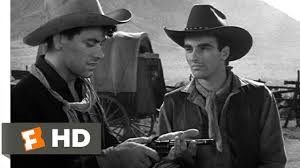
Cherry wants to hold Matt’s gun and tells him its “awful nice”

Matt casually keeps a hand on his hip while shooting
The night before the cattle drive starts the cowboys relax by playing music or cards. There is fight when one man says something about another man’s hat, (because it isn’t really a western style hat…but the man gives a western style punch when his hat is insulted. Remember how sensitive westerners are about their hats!). Groot bets his false teeth in a poker game and loses them to the Indian cowboy named Quo. Just as the bracelet is something serious for us to keep our eyes on, the false teeth are a comical one. Matt gave the teeth to Groot, but Groot loses them to Quo who proudly announces that he will now call himself “Two Jaw Quo”. This is a comical counterpoint to Tom giving his bracelet to his girlfriend who is murdered by the Comanche warrior who steals the bracelet.
The scene becomes serious when Dunson enters and tells the men about the challenges and dangers of the cattle drive and says he won’t force anyone to go, but if they do agree to go they will have to commit to the whole trip. He then asks each man to sign a contract. This is the second time in the film that written contracts are mentioned. Years before Dunson told the Wagon Master of his wagon train that he had not signed a contract to go to California and that if he had done so he would honor it.
Something I want you to pay attention to throughout the film is how many times matters of law are raised. It is also curious how much emphasis the story places on the importance of written contracts in a world where most men could not read or write (Groot marks an X for his name on the contract).
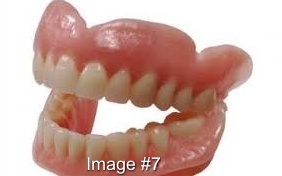
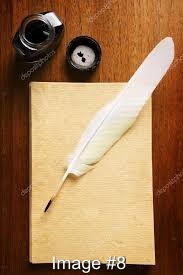
Since most westerners had limited education the most powerful commitment they could make was “giving their word” and “shaking on it” (shaking hands). To “give your word” was to make a promise and for a westerner “keeping his word” was a duty bound to his honor. A man who “broke his word” lost all honor in the eyes of his fellows and in the West, as in feudal Japan, honor was the most important thing a man or woman had. But Dunson wants more than their word, he wants his cowboys to sign a written contract. Yet, how could he enforce such a contract when there is probably no courthouse or even a lawman within three days ride of his ranch? Moreover, on the trail itself they would be weeks away from any towns or courthouses or lawmen. But Tom makes it clear how seriously he takes the contract. He considers it to be a legally binding document. Yet, I will remind you that this is the man who was rustling his neighbor’s cattle earlier the very same day! This is also the man who killed the Mexican guard who claimed to be protecting the legal rights of his employer. Do you see the contradictions in Thomas Dunson’s character? If you don’t know what a “contradiction” is look up the meaning of the word before you screen the next excerpt.
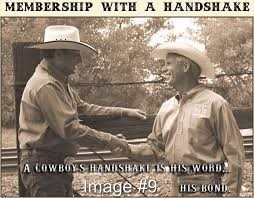
Finally, the cattle drive begins at dawn with Dunson and Matt looking out over their vast herd and the men who will help them drive their cattle a thousand miles to the North. “Take them to Missouri, Matt”, says Dunson, and Matt gives a cowboy yell of “yeehaw”, which all the other cowboys answers, each with their own unique and wonderful cowboy yell. It’s one of the most thrilling moments in the film and it really makes my blood boil. Contrast how John Ford used his closeups with how Hawkes uses these. Ford almost always shows us a closeup of someone who isn’t moving or speaking, Ford used closeups as portraits to reveal what sort of person he or she was, good or bad, selfish or kind, intelligent or stupid. Howard Hawkes’ closeups are not telling us anything about what these men are like inside. Hawkes is showing us that even though the men are beginning a long and dangerous journey they are cowboys who yell with the kind of joy soldiers yell with before a battle in which they know they might be killed. “Yeehaw” is an affirmation of life itself even in the face of death. Doesn’t that remind you just a little bit of “Banzai!”
